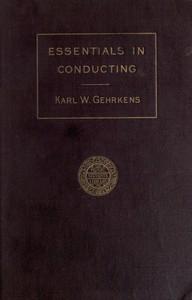Read this ebook for free! No credit card needed, absolutely nothing to pay.
Words: 27794 in 12 pages
This is an ebook sharing website. You can read the uploaded ebooks for free here. No credit cards needed, nothing to pay. If you want to own a digital copy of the ebook, or want to read offline with your favorite ebook-reader, then you can choose to buy and download the ebook.
belonging to the upper classes as well as the proletariat. When once the barrier of formality has been broken down, such gatherings, especially when directed by a leader who is a good musician as well as a good mixer, may well become the means of interesting many thousands of men and women in the more artistic phases of music; may indeed eventually transform many a community, not only from a crowd of individuals into a homogeneous social group, but may actually change the city or village from a spot where ugliness has reigned supreme to one where the dominating note is beauty--beauty of service as well as beauty of street and garden and public building; and where drama and music, pictures and literature, are the most cherished possessions of the people. In a place which has been so transformed, the "eight hours of leisure" that have so troubled our sociologists will present no problem whatever; for the community chorus, the neighborhood orchestra, the music and dramatic clubs, and the splendid libraries and art galleries will assume most of the burden of providing a worthy use of leisure.
After the chorus has gotten well on its feet, it will probably be best to purchase copies of some larger and more elaborate book, the copies being either owned by individual members or else purchased out of treasury funds, and therefore belonging to the organization. At the first "sing" it will be a distinct advantage if no financial outlay whatever is required of the individuals composing the chorus.
In conclusion, let us urge the leader of community singing to decide beforehand just what songs are to be used, and to study the words of these songs carefully so as to be able to imbue the chorus with the correct spirit of each one, having at his tongue's end the story of the song and other pointed remarks about it that will enliven the occasion and keep things from stagnating. He will, of course, frequently find it necessary to modify his plan as the "sing" progresses, for one of the most necessary qualifications in the leader is flexibility and quick wit. But if he has a definite program in mind and knows his material so well that he does not need to look at his book, he will be much more likely to succeed in holding the interest of his chorus throughout the "sing."
If possible, let the "sing" be held, in some hall not connected with any particular group of people, so that all may feel equally at home ; and, in giving the invitation for the first meeting, make sure that no group of people shall have any ground whatsoever for feeling slighted, even in the smallest degree.
Granting the various factors that we have been recommending, and, most important of all, having provided the right type of leader to take charge of the "sings," the enterprise cannot but have significant results along both musical and sociological lines.
THE ORCHESTRAL CONDUCTOR
The above description has reference, of course, to conducting an orchestra of approximately symphonic dimensions, and does not refer to the comparatively easy task of directing a group consisting of piano, violins, cornet, trombone, and perhaps one or two other instruments that happen to be available. In organizing an "orchestra" of this type, the two most necessary factors are a fairly proficient reader at the piano , and at least one skilful violinist, who must also be a good reader. Given these two indispensable elements, other parts may be added as players become available; and although the larger the number of wind instruments admitted, the greater the likelihood of out-of-tune playing, yet so great is the fascination of tonal variety that our inclination is always to secure as many kinds of instruments as possible.
The chief value to be derived from ensemble practice of this type is not, of course, in any public performances that may be given, but is to be found in the effect upon the performers themselves, and the principal reason for encouraging the organization of all sorts of instrumental groups is in order to offer an opportunity for ensemble playing to as many amateur performers as possible. For this reason, unavoidable false intonation must not be too seriously regarded.
In dealing with a smaller group , it will be well to have the piano in the middle, the lower strings at the left, the winds at the right, and the violins in their usual position. The diagram will make this clear. It is to be noted that this seating plan is only suggestive, and that some other arrangement may frequently prove more satisfactory.
In a symphony orchestra of about one hundred players, the proportion of instruments is approximately as follows:
It will be noted that out of about one hundred players almost three-quarters are performers upon stringed instruments, and it is this very large proportion of strings that gives the orchestral tone its characteristic smoothness, its infinite possibilities of dynamic shading, its almost unbelievable agility, and, of course, its inimitable sonority. The wind instruments are useful chiefly in supplying variety of color, and also in giving the conductor the possibility of occasionally obtaining enormous power by means of which to thrill the hearer at climacteric points.
Our reason for supplying the above information is mainly in order to direct attention to the small proportion of wind instruments, and to warn the amateur conductor not to admit too large a number of cornets and trombones to his organization, lest the resulting effect be that of a band rather than that of an orchestra. If there are available a great many wind instruments and only a few strings, it will probably be better to admit only a few of the best wind instrument players to the orchestra and to organize a band in order to give the rest of the players an opportunity for practice. It will probably be necessary for the conductor to warn his wind players to aim at a more mellow tone than they use when playing in a band, in order that the brass tone may blend with the string tone. In the case of the reed instruments, this will sometimes mean a thinner reed in orchestra work than is used in bands.
Free books android app tbrJar TBR JAR Read Free books online gutenberg
More posts by @FreeBooks

: Prince or Chauffeur? A Story of Newport by Perry Lawrence McFall J V Illustrator - Newport (R.I.) Fiction


: Minna von Barnhelm Viisinäytöksinen huvinäytelmä by Lessing Gotthold Ephraim Lahdensuo Jalmari Translator - Comedies Harvard Classics








